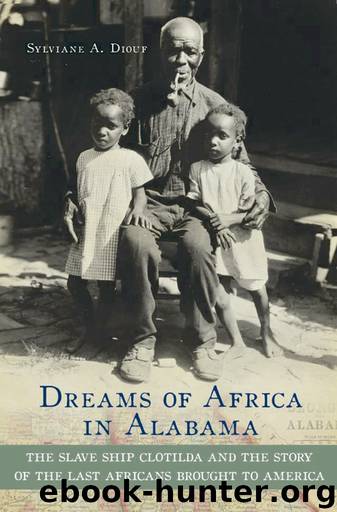Dreams of Africa in Alabama by Sylviane A. Diouf

Author:Sylviane A. Diouf
Language: eng
Format: epub
Publisher: Oxford University Press
Published: 2007-02-27T16:00:00+00:00
CHAPTER EIGHT
Between Two Worlds
AS THE LAST DECADE of the nineteenth century opened, King Glèlè died after a reign of more than forty years. Wherever they were, in Mobile, Havana, or Rio, the people he had sold away would have rejoiced had they known. Some of the deportees to Brazil had been freed only a year before in 1888. The men and women of African Town who had been taken from his barracoon in Ouidah were now in their forties and fifties, parents and grandparents of two generations who had never feared the king and the soldiers of Dahomey. To these young men and women, the most concrete expression of their parents’ ordeal was the face of an old white man down the road.
After retiring from the river because the Negroes had become uppity, Timothy Meaher spent his time running the Bay City Lumber Company and the Mobile Steam Brick Works with his brothers and his sons, James and Augustine. They were still powerful and, as years went by, the family became even wealthier. But the brothers were getting old. Burns, the youngest, was the first to die, in 1880. James followed in February 1885. At seventy-four, he was hailed as one of the oldest steamboat men in the state. One of his pallbearers was none other than William Foster. About a year later Timothy developed paralysis and became housebound.1 On March 3, 1892, the Catholic priest of St. Francis Xavier Church near Three Mile Creek was summoned to his side. The father gave him the last sacraments, and the captain passed away. It was a peaceful death of old age, at eighty. Timothy Meaher’s passing made the news not only in Mobile, but as far away as New York. The Daily Register gave him a hefty obituary, calling him “a venerable steamboat man . . . one of the best and most successful steamboatmen, who plied the rivers in the palmiest days of the business.”2 The notice dedicated twelve lines to his days as a captain, and fifty-nine to “the famous event with which his name was identified.”
Meaher was, first and foremost, the man of the Clotilda, or the Clotilde, as the newspaper called the ship. It was the arrival of the “160 slaves” in “the spring of 1861,” their hiding in the canebrake, the “disposal of the cargo,” the captain’s trial, and the “African Colony” that were the highlights of Meaher’s life. In a dispatch from Mobile, the New York Times saluted the death of the “Last of the Slave Traders.” Adding its own copious mistakes and prejudices to the story, the Times informed its readers,
Timothy Meaher, who died to-day, was noted as the importer of the last cargo of slaves brought to the United states. This was in the Spring of 1861. He chartered the schooner Clotilde, which brought 160 negroes and managed to spirit them into a cane brake 100 miles up stream. . . . The thirty negroes that fell to his share he settled in a suburb of this city.
Download
This site does not store any files on its server. We only index and link to content provided by other sites. Please contact the content providers to delete copyright contents if any and email us, we'll remove relevant links or contents immediately.
| African-American Studies | Asian American Studies |
| Disabled | Ethnic Studies |
| Hispanic American Studies | LGBT |
| Minority Studies | Native American Studies |
Cecilia; Or, Memoirs of an Heiress — Volume 1 by Fanny Burney(32435)
Cecilia; Or, Memoirs of an Heiress — Volume 2 by Fanny Burney(31871)
Cecilia; Or, Memoirs of an Heiress — Volume 3 by Fanny Burney(31856)
The Great Music City by Andrea Baker(31359)
We're Going to Need More Wine by Gabrielle Union(18969)
All the Missing Girls by Megan Miranda(15577)
Pimp by Iceberg Slim(14395)
Bombshells: Glamour Girls of a Lifetime by Sullivan Steve(13976)
Talking to Strangers by Malcolm Gladwell(13222)
Norse Mythology by Gaiman Neil(13207)
Fifty Shades Freed by E L James(13157)
For the Love of Europe by Rick Steves(13000)
Mindhunter: Inside the FBI's Elite Serial Crime Unit by John E. Douglas & Mark Olshaker(9201)
Crazy Rich Asians by Kevin Kwan(9167)
The Lost Art of Listening by Michael P. Nichols(7408)
Enlightenment Now: The Case for Reason, Science, Humanism, and Progress by Steven Pinker(7235)
The Four Agreements by Don Miguel Ruiz(6632)
Bad Blood by John Carreyrou(6552)
Weapons of Math Destruction by Cathy O'Neil(6146)
